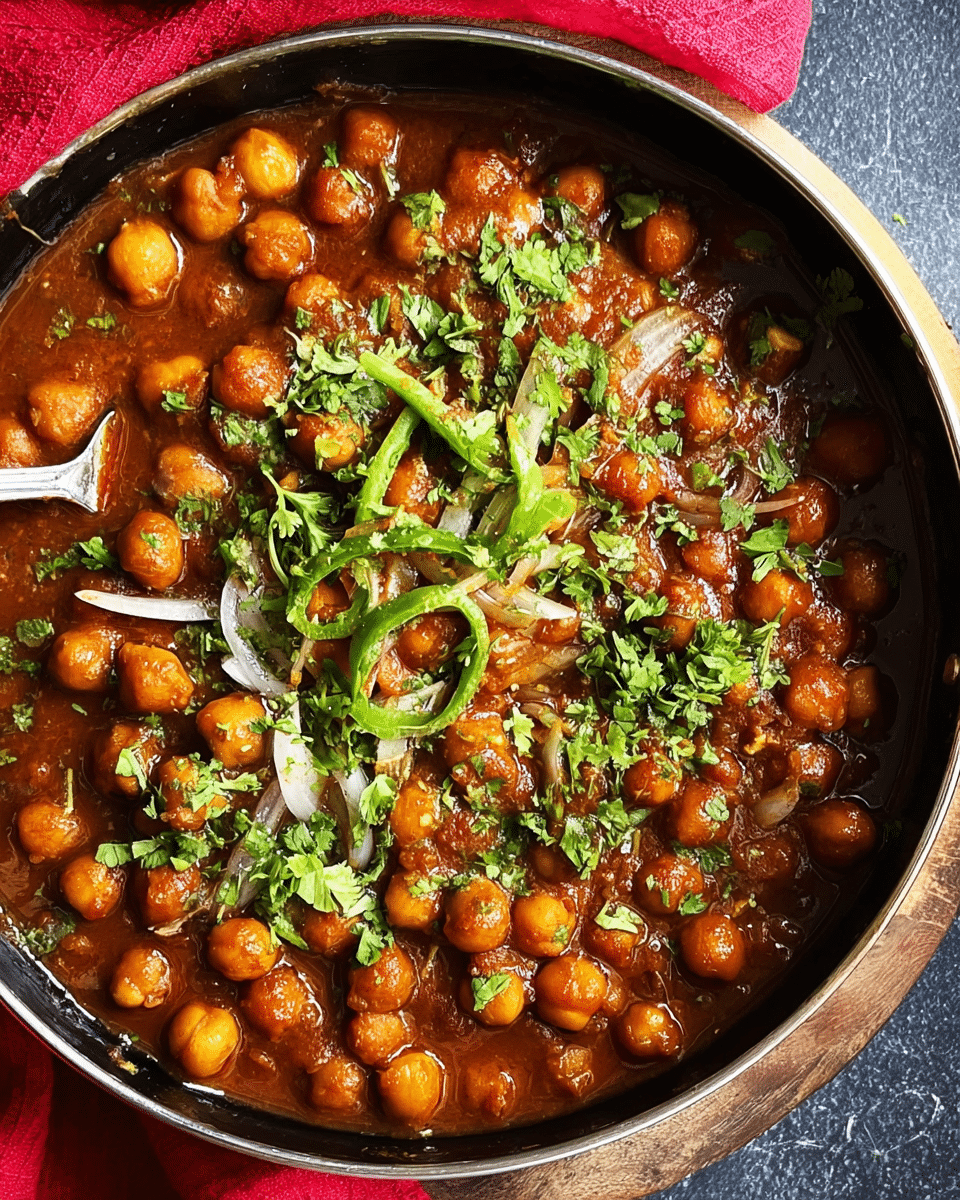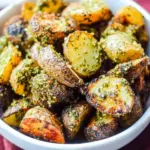The robust and aromatic flavors of this Punjabi Chole make it a showstopper in Indian cuisine. The richness of caramelized onions and tomatoes combined with a unique blend of spices like amchur, anardana, and kasuri methi gives this chickpea curry its iconic depth and color.
Whether served alongside fluffy bhatura, steamed basmati rice, or warm parathas, this dish delivers both comfort and complexity. The finishing tadka with ghee and blistered chilies takes it to another level – a must-try for fans of spicy and soulful Indian meals.
Full recipe:
Ingredients:
-
1 cup dried chickpeas (or 2½ to 3 cups canned chickpeas)
-
2 cups water (for pressure cooking)
-
1 black tea bag or 1 tbsp loose leaf tea or 2 dried amla pieces
-
1 bay leaf
-
1 black cardamom
-
4 green cardamoms
-
1 inch cinnamon stick
-
2 cloves
-
2 tablespoons oil
-
1½ cups finely chopped onions (or 1¼ cups processed)
-
1 green chili (slit, optional)
-
¾ to 1 tablespoon ginger garlic paste
-
1 cup chopped or pureed tomatoes
-
¾ to 1 teaspoon salt (adjust to taste)
-
½ to ¾ teaspoon Kashmiri red chili powder
-
⅛ teaspoon turmeric
-
1 tablespoon chole masala (or homemade blend)
-
¾ teaspoon garam masala
-
1 teaspoon coriander powder
-
¼ to ½ teaspoon amchur (optional)
-
1 teaspoon kasuri methi (dried fenugreek leaves)
-
1 tablespoon ghee
-
½ inch ginger (julienned)
-
2 to 4 green chilies (slit)
-
¼ teaspoon hing (asafoetida)
-
2 tablespoons coriander leaves (chopped)
Directions:
-
Soak dried chickpeas in water overnight (or at least 8 hours). Drain and rinse well.
-
Boil 1 cup water, add loose leaf tea and steep for 2–3 mins. Strain. Combine chickpeas, 2 cups water, tea decoction (or tea bag), bay leaf, cardamoms, cinnamon, and cloves. Pressure cook for 5–6 whistles or 16 mins in Instant Pot. Chickpeas should be soft but not mushy.
-
In a pan, heat oil and add cinnamon, cloves, cardamoms, bay leaf. Let them sizzle.
-
Add onions and green chili. Sauté until golden brown.
-
Add ginger garlic paste and sauté for 1 minute.
-
Add tomatoes and cook until they break down and the raw smell disappears.
-
Add salt, red chili powder, turmeric, and chole masala. Cook for 3–4 mins.
-
Pour in cooked chickpeas along with the cooking liquid and 1 cup fresh water.
-
Simmer covered for 18–20 mins until gravy thickens. Add kasuri methi. Adjust salt or spices if needed.
-
For tadka: heat ghee in a small pan. Fry green chilies, then add ginger juliennes and hing. Pour over the chole.
-
Garnish with coriander leaves. Serve hot with bhatura, naan, or basmati rice.
Prep Time: 10 minutes (excluding soaking)
Cooking Time: 45 minutes
Total Time: 55 minutes
Kcal: 229 kcal
Servings: 4 servings
The Cultural Significance of Chole
Punjabi Chole is more than just food; it’s a cultural icon. In the streets of North India, especially in dhabas (roadside eateries), chole is served piping hot alongside bhaturas or pooris. This iconic pairing, known as “Chole Bhature,” has become synonymous with Sunday brunches and festive indulgences in Indian homes.
Historically, legumes like chickpeas (kabuli chana) have played an essential role in Indian diets due to their high protein content and accessibility. The preparation of chole varies from household to household, but the essence of the dish—slow-cooked chickpeas in a well-spiced tomato and onion gravy—remains consistent. It exemplifies the idea of elevating simple ingredients through technique and tradition.
In Punjab, the dish is often prepared during langars (community meals) in gurdwaras (Sikh temples), highlighting its communal and inclusive nature. Sharing a plate of chole transcends religious and regional boundaries, representing unity, generosity, and warmth.
The Distinctive Spice Blend
What makes Punjabi Chole unique is the spice blend, often referred to as “Chole Masala.” This isn’t your everyday garam masala. It’s a specific combination of spices including dried mango powder (amchur), anardana (dried pomegranate seeds), black cardamoms, cinnamon, and dried red chilies. The presence of these spices imparts a complex flavor—one that is tangy, earthy, smoky, and slightly sweet all at once.
Home cooks often prepare their own chole masala to control the heat and depth of flavor. While store-bought blends are available and convenient, they can sometimes overpower or lack balance. The homemade version is usually fresher and more aromatic, providing a more authentic result.
Tea decoction or dried amla is sometimes used during the cooking of chickpeas to give them a darker hue and a subtle underlying flavor. This technique not only enhances the aesthetic of the dish but also complements the spice profile beautifully. These little touches make the dish truly distinctive and rooted in culinary wisdom.
Flavor Profile and Texture
The texture of well-made chole is both hearty and comforting. The chickpeas are cooked until soft but not mushy, allowing them to absorb the rich masala without falling apart. The gravy is thick and luscious, with caramelized onions, tangy tomatoes, and robust spices all melding together to create a deeply satisfying dish.
The flavor is a medley of spicy, tangy, and slightly sweet notes. The spices are toasted or slow-cooked to unlock their full potential, adding layers of taste to every bite. The finishing touch—a tempering (tadka) of ghee with blistered green chilies, julienned ginger, and hing—adds another dimension of flavor that lingers on the palate and elevates the entire dish.
Chole is often garnished with fresh coriander leaves, and sometimes served with slices of onion, lemon wedges, or pickles on the side. This not only enhances presentation but also adds freshness and acidity to balance the richness of the gravy.
Versatility of the Dish
Punjabi Chole is a versatile dish that complements a variety of accompaniments. While it is traditionally paired with bhatura (a deep-fried leavened bread), it also goes well with poori, plain paratha, naan, kulcha, or even simple steamed basmati rice. Each combination brings out different nuances of flavor, making chole an incredibly adaptable dish.
Beyond traditional pairings, chole can also be used creatively in wraps, sandwiches, or served over toast as a hearty topping. In contemporary Indian fusion cuisine, chefs are even pairing chole with pasta or using it as a base for baked dishes.
Additionally, chole can be prepared in large quantities, making it an excellent option for batch cooking and meal prep. It stores well in the refrigerator for a few days and can also be frozen for longer shelf life. Its flavors only deepen and improve with time, making it perfect for next-day meals.
Nutritional Value and Dietary Benefits
Chickpeas, the main ingredient in chole, are a nutritional powerhouse. They are rich in plant-based protein, dietary fiber, complex carbohydrates, and essential vitamins and minerals like folate, iron, and magnesium. This makes chole an excellent meal choice for vegetarians and vegans seeking to increase their protein intake.
The inclusion of spices like turmeric, ginger, garlic, and chili not only enhances flavor but also contributes to health. These spices are known for their anti-inflammatory, digestive, and antioxidant properties. Using tea or amla in the cooking process further aids in digestion and adds to the nutritional profile of the dish.
Prepared with minimal oil and without heavy cream or dairy, chole is a wholesome, guilt-free option. It’s naturally gluten-free and can easily be made oil-free or low-fat for those with specific dietary restrictions. This makes it a well-rounded, nutrient-dense meal that caters to a wide range of diets and lifestyles.
Traditional Cooking Methods and Modern Adaptations
Traditionally, Punjabi Chole is cooked in a pressure cooker, which ensures that the chickpeas are perfectly tender while retaining their shape. The masala is usually prepared separately, allowing the onions, tomatoes, and spices to cook thoroughly before being combined with the chickpeas.
In modern kitchens, Instant Pots and electric pressure cookers have become popular tools for making chole more efficiently. These devices reduce cooking time without compromising on flavor or texture. With the use of canned chickpeas, the preparation can be further simplified, making it an ideal recipe even for busy weekdays.
Despite the availability of modern tools, the essence of chole remains unchanged. It’s still about building flavors step-by-step, allowing the spices to bloom, and giving the dish time to develop its signature taste. Whether cooked traditionally or with shortcuts, chole remains a deeply satisfying and hearty meal.
Regional and Personal Variations
Every household has its own version of chole, passed down through generations. Some prefer it spicier, others tangier; some may add potatoes or paneer for variation, while others keep it classic. In Delhi, chole is often served with kulchas and garnished generously with chopped onions and tamarind chutney, creating a sweet-sour-spicy trifecta.
In Punjab, the use of homemade ghee and deeper spice blends give the dish a more rustic, earthy flavor. The way the chickpeas are soaked, the kind of tea or amla used, or the specific chole masala blend—all contribute to subtle differences that make every version of chole unique.
Some families even add boiled potatoes, pomegranate seeds, or fresh mint leaves to enhance the flavor or texture. Whether it’s made as a weekend treat, festive dish, or everyday curry, chole adapts beautifully to personal preferences.
Serving Suggestions and Presentation Tips
Punjabi Chole is best served hot, garnished with fresh coriander leaves, a dash of lemon juice, and finely sliced onions. For an authentic dhaba-style experience, pair it with deep-fried bhaturas or flaky puris. A side of carrot sticks, cucumber slices, and pickled onions not only enhances the meal aesthetically but also adds a fresh crunch.
For a more balanced meal, chole can be paired with jeera rice or brown rice and a simple salad. When serving to guests, present chole in a copper or clay bowl for a rustic and traditional look, and include sides like papad, pickle, and a yogurt-based drink like chaas or lassi to complete the spread.
Chole also makes a great option for meal boxes or potluck events, as it retains heat well and continues to develop flavor over time.
Conclusion
Punjabi Chole is not just a dish—it’s an experience that embodies the rich culinary heritage of North India. From its deep, layered flavors to its hearty, nourishing nature, chole stands as a testament to the power of traditional Indian cooking. It’s a dish that brings people together, whether it’s during a family lunch, a community gathering, or a festive celebration.
Its adaptability, nutritional value, and bold flavors make it a favorite across cultures and continents. Whether you’re a seasoned cook or a beginner in the kitchen, preparing chole offers an opportunity to engage with Indian cuisine in a meaningful and delicious way. No matter how you serve it or tweak it to suit your taste, Punjabi Chole is sure to leave a lasting impression on every plate it graces.






